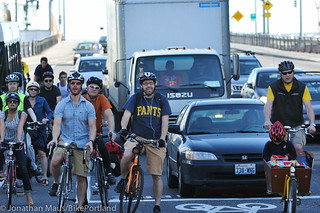The details of the Portland Bureau of Transportation’s plans to invest in downtown bicycle access are getting clearer. As we shared back in February, PBOT has applied for $6 million in regional flexible funding (administered by Metro) in order to improve the transportation network in the downtown core.
Much about the plan — like specific locations and facility-types — remains undecided; but PBOT’s grant application (published on Metro’s website) provides the most detail we’ve seen yet about the project.
According to PBOT, their Portland Central City Multi‐Modal Safety Improvements project will, “plan for and address safety and access issues resulting from competing demands on transportation infrastructure in Portland’s central city.” From the description it’s clear PBOT is approaching this project as much more than simply a “bike project.” To them this is about updating and redesigning the existing roadways to respond to current demands, facilitate future needs, and meet our adopted mode share goals. Here’s an excerpt from the description:
This project will result in a strategy that identifies a multi‐modal transportation network that complements adjacent land uses, preserves capacity for important uses, and accommodates and encourages the already significant active transportation use in the central city today. The project will then identify and fund priority investments in active transportation.
To make the case for this investment, PBOT has boiled their argument down to two main points: the need to build a system that can accommodate more bicycle traffic (such as 25% bike mode share by 2030), and the need to make those trips safer. (Statistical models and usage trends prove that as Portland’s population increases, a larger share of the trip burden must fall on non-automobile modes.)
Here’s another key excerpt:
Beyond accommodating growth and achieving modal targets, however, lies a more serious issue of safety on the corridors leading in to and out of Portland’s central city. Fourteen of the top twenty high crash intersections for bicycling (1999‐2008) are within the proposed project area, and account for 94 (74%) of the 127 reported crashes that occurred at those 20 top locations. Similarly, six of the top twenty high crash intersections for walking (1999‐2008) are within the proposed project area, and account for 44 (31%) of the 140 reported crashes that occurred at those 20 top locations.
If these safety issues aren’t addressed, PBOT writes, we’ll see “declining active transportation use in the central city.”
As for PBOT’s vision of what type of facilities they’ll build with this money, the application says they want to, “create as much separation between people walking or bicycling and automobile traffic.” And for PBOT, creating bikeways separated from auto traffic is, “both recognized and demonstrated to be a foundation for increasing non‐auto trips.”
PBOT describes the central city as the region’s top trip destination (as per Metro’s 2040 growth plan), a place where roads are used by many underserved communities, and a place with lackluster bicycle access. “Feeding into this background,” PBOT writes, “are the common complaints among Portland residents of how they feel “abandoned” by the city’s bikeway network once they access the Central City and how that creates a barrier to increased use.”
That feeling was summed up by a member of the City’s Bicycle Advisory Committee at their meeting earlier this month. Yonit Sharaby, a new mom who lives in northwest Portland, told a PBOT staffer and the committee members that when she takes friends on a bike ride they avoid downtown. “Portland is the city of bikes on the east side,” she said, “Portland is not the city of bikes on the west side.”
Hopefully this project — which PBOT says will be, “one of the most significant investments in active transportation this region has experienced in several years” — will change that once and for all.
— Metro is accepting public comments on this and 28 other projects from around the region until June 7th. See their website for more details.


